Pore-Mouth Structure of Highly Agglomerated Detonation Nanodiamonds
Abstract
:1. Introduction
2. Materials and Methods
2.1. Sample Preparation
2.2. Surface Analysis of Nanodiamonds
2.3. Adsorption of Nitrogen at 77 K, Argon at 87 K, and Water at 298 K on Nanodiamonds
3. Results
3.1. Chemical and Structural Changes of Nanodiamond Aggregates upon Heating
3.2. Effect of Heating Time on the Pore Structure of Nanodiamond Aggregates
4. Discussion
5. Conclusions
Supplementary Materials
Author Contributions
Funding
Institutional Review Board Statement
Informed Consent Statement
Data Availability Statement
Acknowledgments
Conflicts of Interest
References
- Dufour, A.; Celzard, A.; Fierro, V.; Broust, F.; Courson, C.; Zoulalian, A.; Rouzaud, J. Catalytic conversion of methane over a biomass char for hydrogen production: Deactivation and regeneration by steam gasification. Appl. Catal. A Gen. 2015, 490, 170–180. [Google Scholar] [CrossRef]
- Grosso-Giordano, N.A.; Schroeder, C.; Xu, L.; Solovyov, A.; Small, D.W.; Koller, H.; Zones, S.I.; Katz, A. Characterization of a Molecule Partially Confined at the Pore Mouth of a Zeotype. Angew. Chem. Int. Ed. 2021, 60, 10239–10246. [Google Scholar] [CrossRef]
- Lanin, S.N.; Platonova, S.A.; Vinogradov, A.E.; Lanina, K.S.; Nesterenko, E.P.; Nesterenko, P. Comparative study of different polar adsorbents for adsorption of water soluble vitamins. Adsorption 2019, 26, 339–348. [Google Scholar] [CrossRef]
- Pacelli, S.; Maloney, R.; Chakravarti, A.R.; Whitlow, J.; Basu, S.; Modaresi, S.; Gehrke, S.; Paul, A. Controlling Adult Stem Cell Behavior Using Nanodiamond-Reinforced Hydrogel: Implication in Bone Regeneration Therapy. Sci. Rep. 2017, 7, 1–15. [Google Scholar] [CrossRef] [Green Version]
- Gusain, R.; Kumar, N.; Ray, S.S. Recent advances in carbon nanomaterial-based adsorbents for water purification. Coord. Chem. Rev. 2020, 405, 213111. [Google Scholar] [CrossRef]
- Jiang, T.; Xu, K. FTIR study of ultradispersed diamond powder synthesized by explosive detonation. Carbon 1995, 33, 1663–1671. [Google Scholar] [CrossRef]
- Pina-Salazar, E.-Z.; Urita, K.; Hayashi, T.; Futamura, R.; Vallejos-Burgos, F.; Włoch, J.; Kowalczyk, P.; Wiśniewski, M.; Sakai, T.; Moriguchi, I.; et al. Water Adsorption Property of Hierarchically Nanoporous Detonation Nanodiamonds. Langmuir 2017, 33, 11180–11188. [Google Scholar] [CrossRef]
- Petit, T.; Girard, H.A.; Trouvé, A.; Batonneau-Gener, I.; Bergonzo, P.; Arnault, J.-C. Surface transfer doping can mediate both colloidal stability and self-assembly of nanodiamonds. Nanoscale 2013, 5, 8958–8962. [Google Scholar] [CrossRef] [Green Version]
- Piña-Salazar, E.-Z.; Kukobat, R.; Futamura, R.; Hayashi, T.; Toshio, S.; Ōsawa, E.; Kaneko, K. Water-selective adsorption sites on detonation nanodiamonds. Carbon 2018, 139, 853–860. [Google Scholar] [CrossRef]
- Ji, S.; Jiang, T.; Xu, K.; Li, S. FTIR study of the adsorption of water on ultradispersed diamond powder surface. Appl. Surf. Sci. 1998, 133, 231–238. [Google Scholar] [CrossRef]
- Osawa, E. Chemistry of Single-Nano Diamond Particles. In Chemistry of Nanocarbons; Akasaka, T., Wudl, F., Nagase, S., Eds.; John Wiley & Sons, Ltd.: Hoboken, NJ, USA, 2010; pp. 413–432. [Google Scholar] [CrossRef]
- Hattori, Y.; Kaneko, K.; Ohba, T. Adsorption Properties. In Comprehensive Inorganic Chemistry II; Elsevier: Amsterdam, The Netherlands, 2013; pp. 25–44. [Google Scholar] [CrossRef]
- Bi, H.; Yin, K.; Xie, X.; Ji, J.; Wan, S.; Sun, L.; Terrones, M.; Dresselhaus, M.S. Ultrahigh humidity sensitivity of graphene oxide. Sci. Rep. 2013, 3, 2714. [Google Scholar] [CrossRef] [PubMed] [Green Version]
- Yao, Y.; Chen, X.; Ma, W.; Ling, W. Quartz crystal microbalance humidity sensors based on nanodiamond sensing films. IEEE Trans. Nanotechnol. 2014, 13, 386–393. [Google Scholar] [CrossRef]
- Piña-Salazar, E.Z.; Sakai, T.; Ōsawa, E.; Futamura, R.; Kaneko, K. Unusual hygroscopic nature of nanodiamonds in comparison with well-known porous materials. J. Colloid Interface Sci. 2019, 549, 133–139. [Google Scholar] [CrossRef]
- Piña-Salazar, E.-Z.; Sagisaka, K.; Hattori, Y.; Sakai, T.; Futamura, R.; Ōsawa, E.; Kaneko, K. Electrical conductivity changes of water-adsorbed nanodiamonds with thermal treatment. Chem. Phys. Lett. X 2019, 2, 100018. [Google Scholar] [CrossRef]
- Yu, X.; Chen, X.; Ding, X.; Chen, X.; Yu, X.; Zhao, X. High-sensitivity and low-hysteresis humidity sensor based on hydrothermally reduced graphene oxide/nanodiamond. Sens. Actuators B Chem. 2019, 283, 761–768. [Google Scholar] [CrossRef]
- Sing, K.S.W.; Williams, R.T. The Use of Molecular Probes for the Characterization of Nanoporous Adsorbents. Part. Part. Syst. Charact. 2004, 21, 71–79. [Google Scholar] [CrossRef]
- Kobori, R.; Ohba, T.; Suzuki, T.; Iiyama, T.; Ozeki, S.; Inagaki, M.; Nakamura, A.; Kawai, M.; Kanoh, H.; Kaneko, K. Fine pore mouth structure of molecular sieve carbon with GCMC-assisted supercritical gas adsorption analysis. Adsorption 2009, 15, 114–122. [Google Scholar] [CrossRef]
- Stehlik, S.; Glatzel, T.; Pichot, V.; Pawlak, R.; Meyer, E.; Spitzer, D.; Rezek, B. Water interaction with hydrogenated and oxidized detonation nanodiamonds—Microscopic and spectroscopic analyses. Diam. Relat. Mater. 2016, 63, 97–102. [Google Scholar] [CrossRef] [Green Version]
- Fujimori, T. Selective probe of the morphology and local vibrations at carbon nanoasperities. J. Chem. Phys. 2012, 136, 064505. [Google Scholar] [CrossRef] [Green Version]
- Pina-Salazar, E.Z.; Kaneko, K. Adsorption of water vapor on mesoporosity-controlled singe wall carbon nanohorn. Colloids Interface Sci. Commun. 2015, 5, 8–11. [Google Scholar] [CrossRef] [Green Version]
- Shenderova, O.A.; Vlasov, I.I.; Turner, S.; Van Tendeloo, G.; Orlinskii, S.B.; Shiryaev, A.A.; Khomich, A.A.; Sulyanov, S.N.; Jelezko, F.; Wrachtrup, J. Nitrogen Control in Nanodiamond Produced by Detonation Shock-Wave-Assisted Synthesis. J. Phys. Chem. C 2011, 115, 14014–14024. [Google Scholar] [CrossRef]
- Thommes, M.; Kaneko, K.; Neimark, A.V.; Olivier, J.P.; Rodriguez-Reinoso, F.; Rouquerol, J.; Sing, K.S.W. Physisorption of gases, with special reference to the evaluation of surface area and pore size distribution (IUPAC Technical Report). Pure Appl. Chem. 2015, 87, 1051–1069. [Google Scholar] [CrossRef] [Green Version]
- Kaneko, K. Determination of pore size and pore size distribution 1. Adsorbents and catalysts. J. Membr. Sci. 1994, 96, 59–89. [Google Scholar] [CrossRef]
- Setoyama, N.; Ruike, M.; Kasu, T.; Suzuki, T.; Kaneko, K. Surface Characterization of Microporous Solids with He Adsorption and Small Angle X-ray Scattering. Langmuir 1993, 9, 2612–2617. [Google Scholar] [CrossRef]
- Vallejos-Burgos, F.; Coudert, F.-X.; Kaneko, K. Air separation with graphene mediated by nanowindow-rim concerted motion. Nat. Commun. 2018, 9, 1812. [Google Scholar] [CrossRef] [Green Version]
- Ozawa, M.; Inaguma, M.; Takahashi, M.; Kataoka, F.; Krüger, A.; Osawa, E. Preparation and behavior of brownish, clear nanodiamond colloids. Adv. Mater. 2007, 19, 1201–1206. [Google Scholar] [CrossRef]
- Ōsawa, E.; Ho, D.; Huang, H.; Korobov, M.V.; Rozhkova, N.N. Consequences of strong and diverse electrostatic potential fields on the surface of detonation nanodiamond particles. Diam. Relat. Mater. 2009, 18, 904–909. [Google Scholar] [CrossRef]
- Krüger, A.; Kataoka, F.; Ozawa, M.; Fujino, T.; Suzuki, Y.; Aleksenskii, A.; Vul’, A.Y.; Ōsawa, E. Unusually tight aggregation in detonation nanodiamond: Identification and disintegration. Carbon 2005, 43, 1722–1730. [Google Scholar] [CrossRef]
- Mitev, D.P.; Townsend, A.T.; Paull, B.; Nesterenko, P.N. Direct sector field ICP-MS determination of metal impurities in detonation nanodiamond. Carbon 2013, 60, 326–334. [Google Scholar] [CrossRef]
- Volkov, D.S.; Krivoshein, P.K.; Mikheev, I.V.; Proskurnin, M.A. Pristine detonation nanodiamonds as regenerable adsorbents for metal cations. Diam. Relat. Mater. 2020, 110, 108121. [Google Scholar] [CrossRef]
- Pentecost, A.; Gour, S.; Mochalin, V.; Knoke, I.; Gogotsi, Y. Deaggregation of nanodiamond powders using salt- and sugar-assisted milling. ACS Appl. Mater. Interfaces 2010, 2, 3289–3294. [Google Scholar] [CrossRef]
- Kowalczyk, P.; Piña-Salazar, E.-Z.; Kirkensgaard, J.J.K.; Terzyk, A.P.; Futamura, R.; Hayashi, T.; Ōsawa, E.; Kaneko, K.; Ciach, A. Reconstructing the fractal clusters of detonation nanodiamonds from small-angle X-ray scattering. Carbon 2020, 169, 349–356. [Google Scholar] [CrossRef]
- Chang, S.L.Y.; Reineck, P.; Williams, D.; Bryant, G.; Opletal, G.; El-Demrdash, S.A.; Chiu, P.-L.; Ōsawa, E.; Barnard, A.S.; Dwyer, C. Dynamic self-assembly of detonation nanodiamond in water. Nanoscale 2020, 12, 5363–5367. [Google Scholar] [CrossRef] [PubMed]
- Opletal, G.; Chang, S.L.; Barnard, A.S. Simulating facet-dependent aggregation and assembly of distributions of polyhedral nanoparticles. Nanoscale 2020, 12, 19870–19879. [Google Scholar] [CrossRef]
- Katsiev, K.; Solovyeva, V.; Mahfouz, R.; Abou-Hamad, E.; Peng, W.; Idriss, H.; Kirmani, A.R. Fresh insights into detonation nanodiamond aggregation: An X-ray photoelectron spectroscopy, thermogravimetric analysis, and nuclear magnetic resonance study. Eng. Rep. 2021, 3, e12375. [Google Scholar] [CrossRef]
- Saberi-Movahed, F.; Brenner, D.W. Impacts of surface chemistry and adsorbed ions on dynamics of water around detonation nanodiamond in aqueous salt solutions. arXiv 2012, arXiv:2102.13312. [Google Scholar]
- Saberi-Movahed, F.; Brenner, D.W. What drives adsorption of ions on surface of nanodiamonds in aqueous solutions? arXiv 2021, arXiv:2102.09187. [Google Scholar]
- Manelli, O.; Corni, S.; Righi, M.C. Water Adsorption on Native and Hydrogenated Diamond (001) Surfaces. J. Phys. Chem. C 2010, 114, 7045–7053. [Google Scholar] [CrossRef]
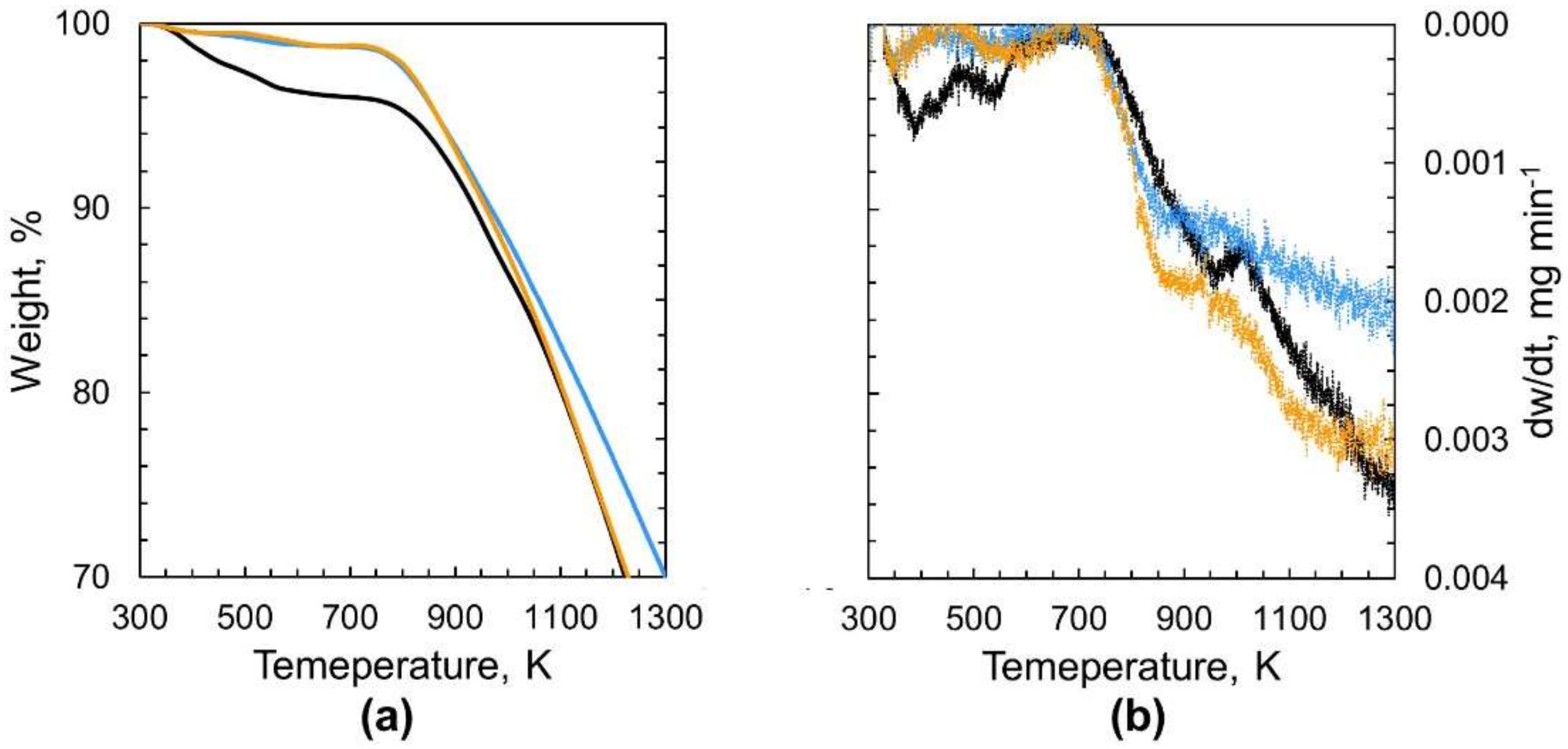
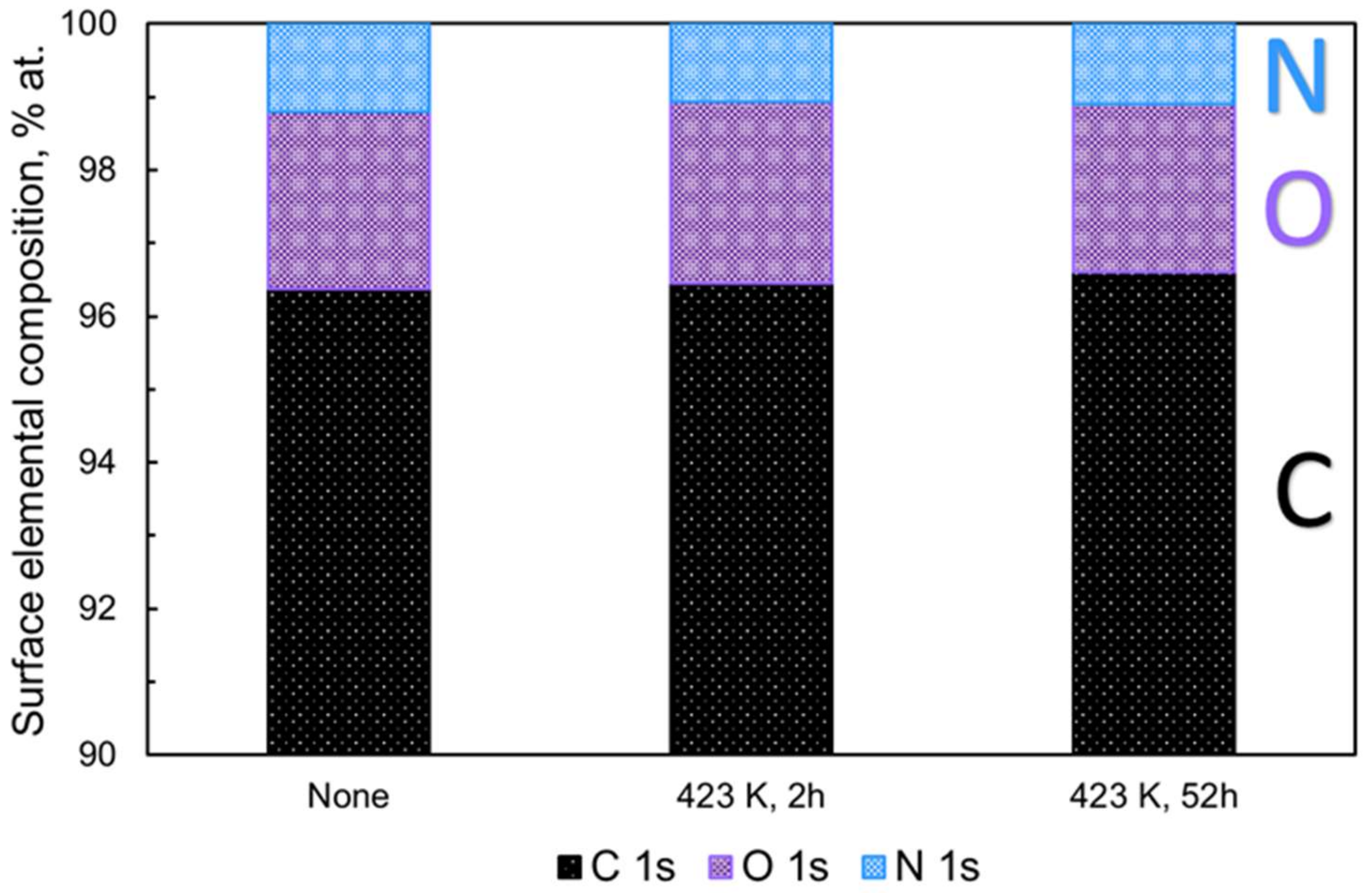
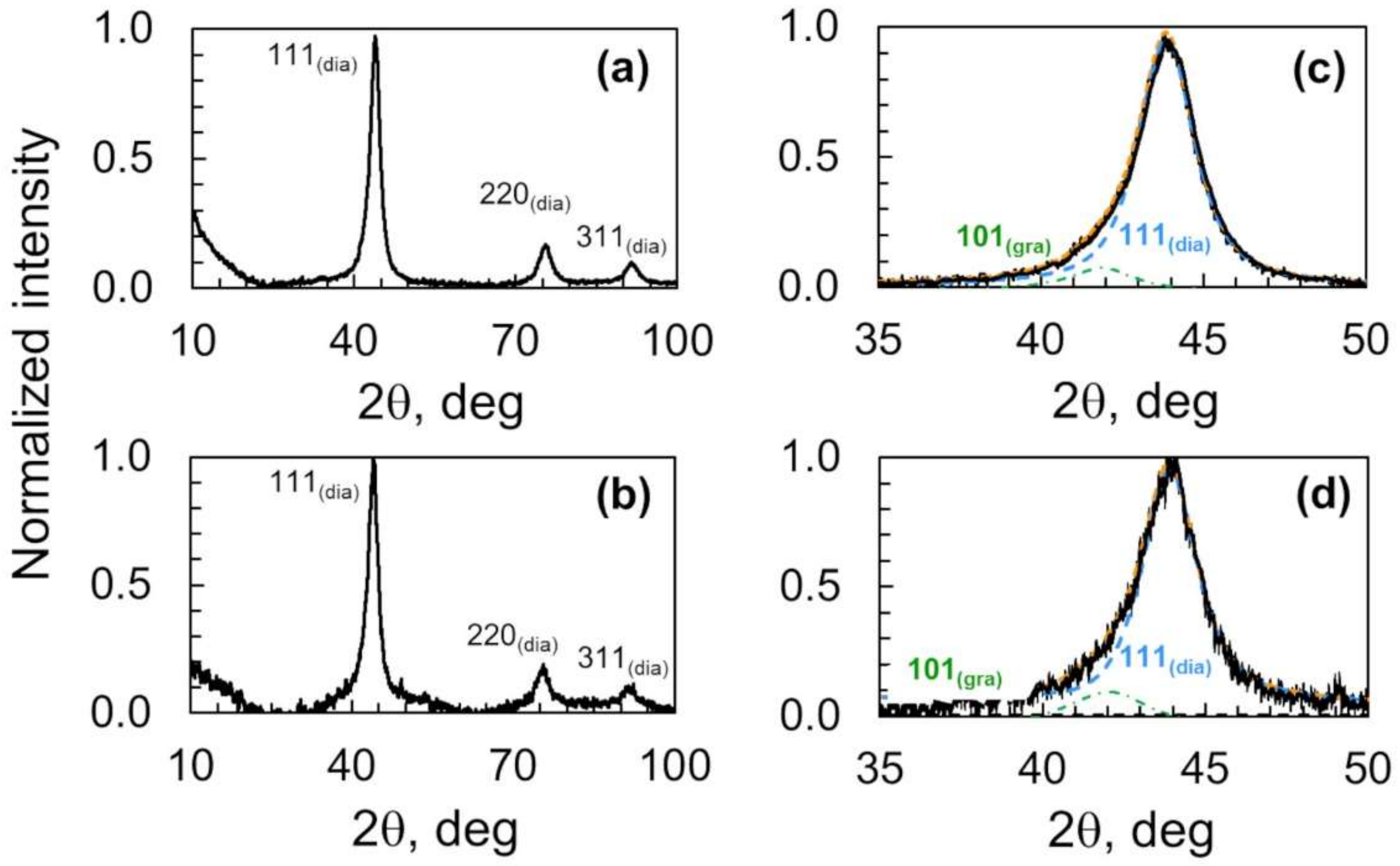
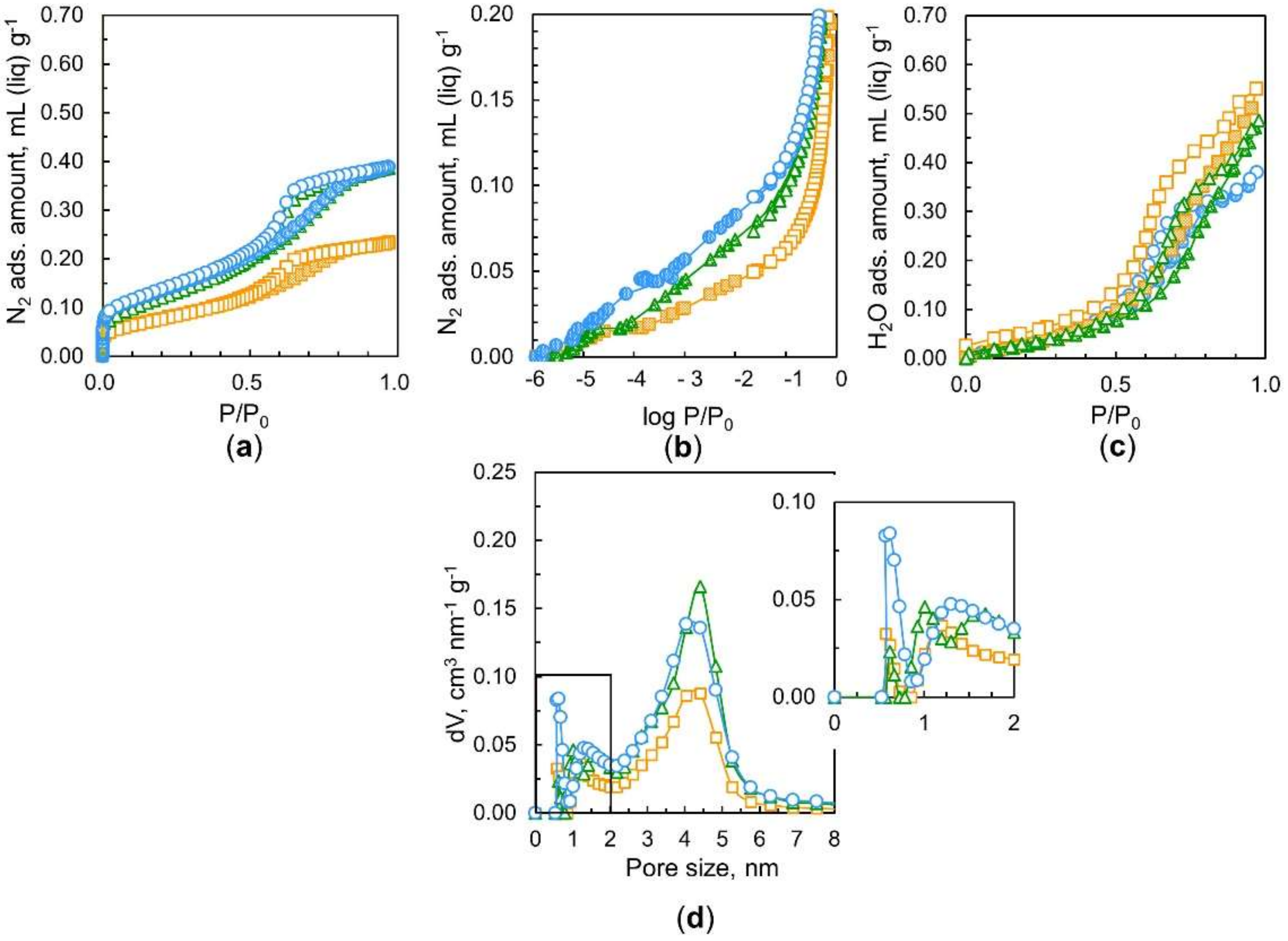
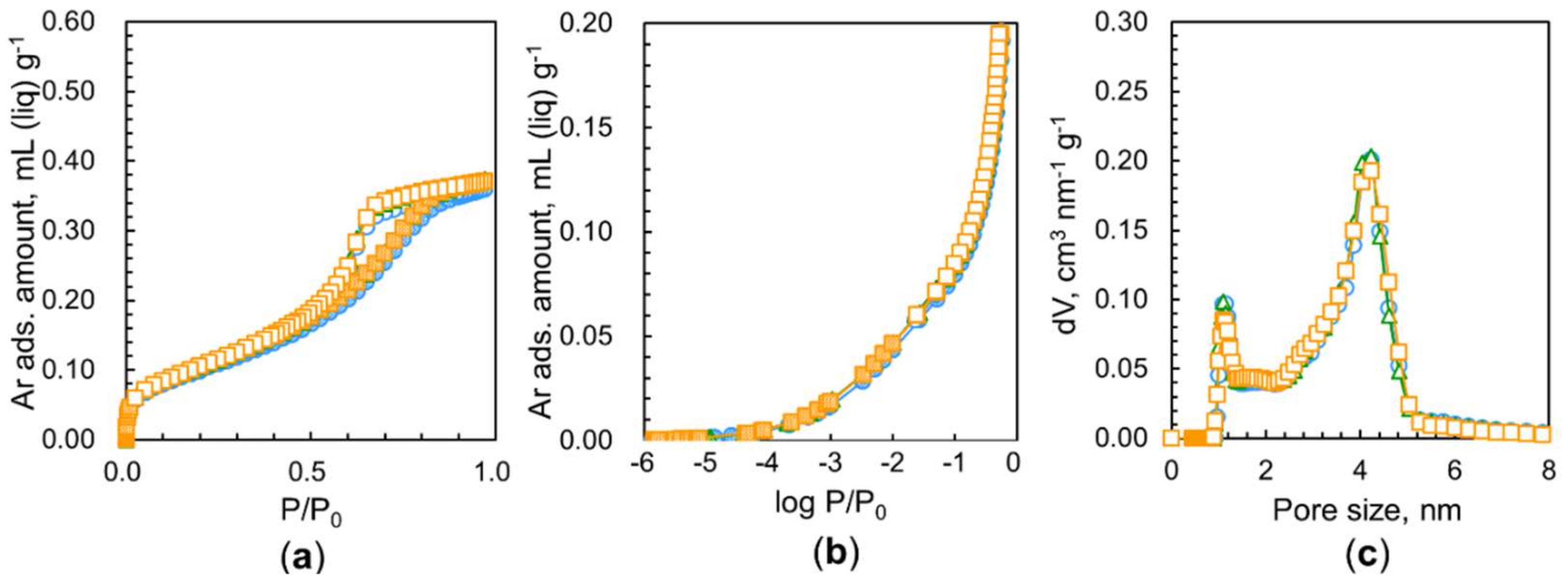
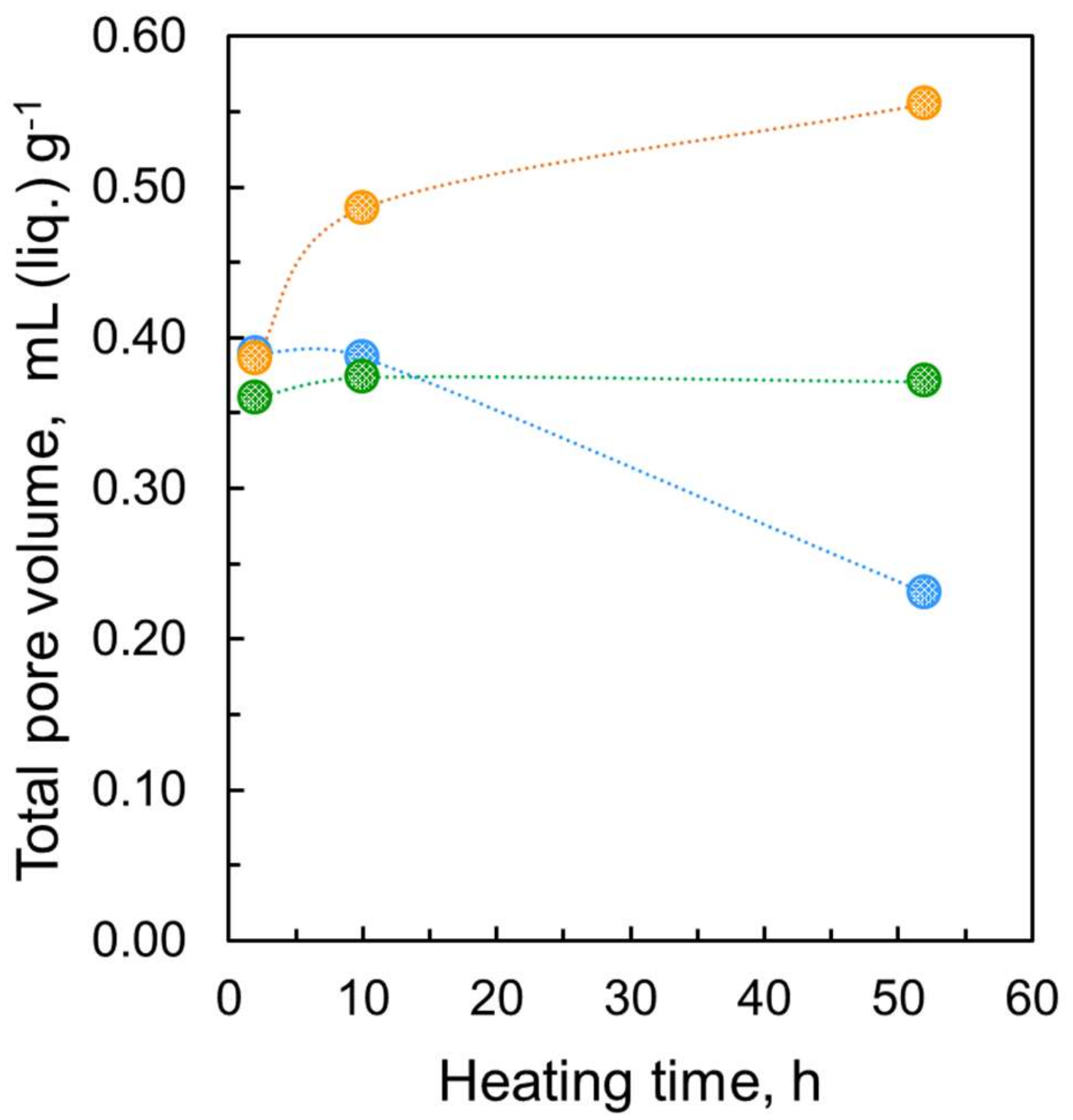
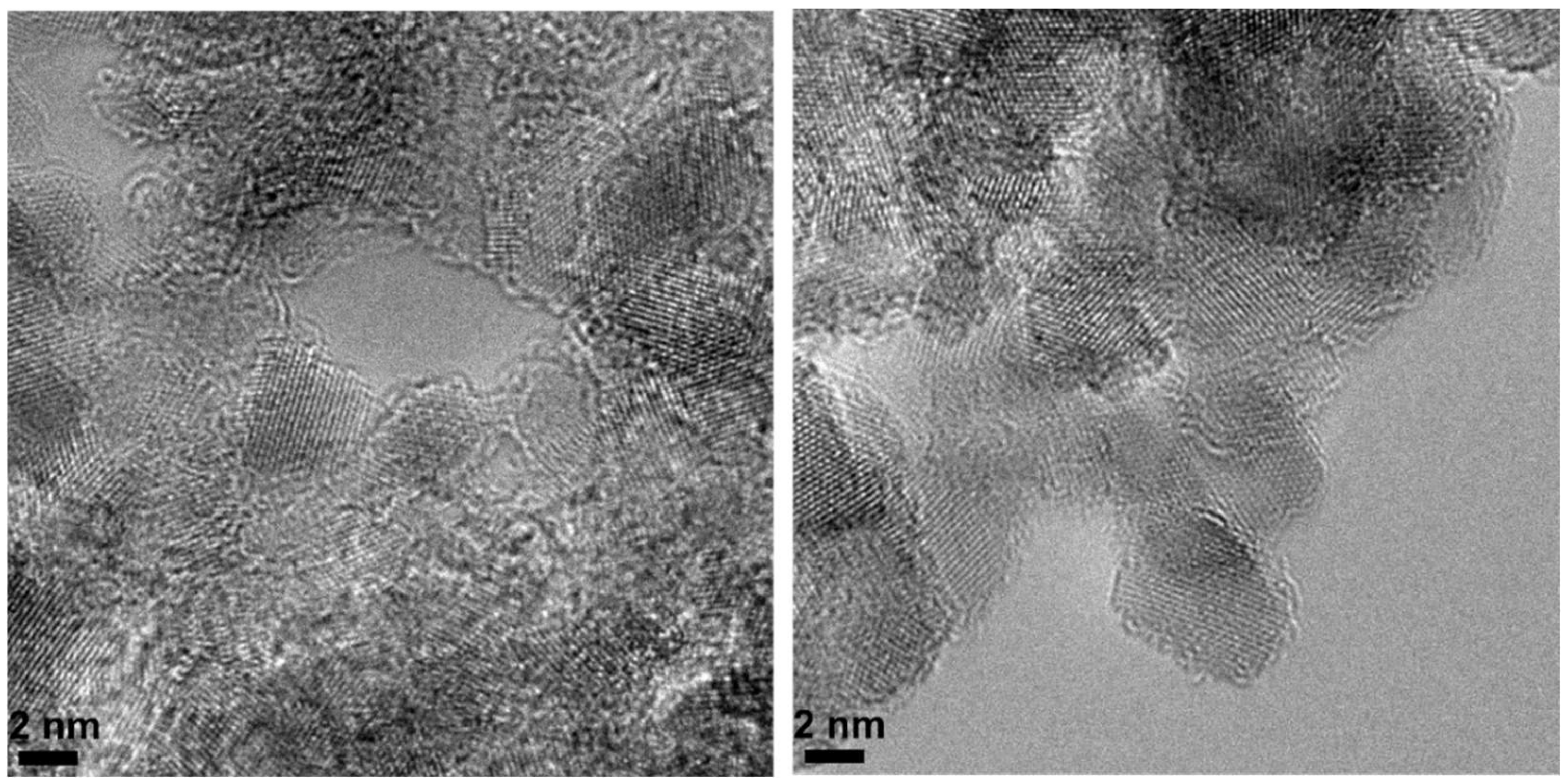
| C 1 s Components | Nonheated ND | 423 K for 2 h | 423 K for 52 h | |||
|---|---|---|---|---|---|---|
| Binding Energy, eV | % Area | Binding Energy, eV | % Area | Binding Energy, eV | % Area | |
| C sp2 | 284.3 | 9.4 | 284.3 | 8.5 | 284.3 | 6.7 |
| C sp3 | 285.2 | 54.2 | 285.1 | 56.4 | 285.1 | 57.2 |
| C-H, C-N, C-OH | 286.2 | 29.8 | 286.2 | 30.1 | 286.2 | 31.1 |
| C-O | 287.3 | 6.6 | 287.5 | 5.0 | 287.5 | 5.0 |
| sp2/sp3 ratio: | 0.17 | 0.15 | 0.12 | |||
| Sample Name | Phase Name | Crystalline Plane | Peak Position 2θ, deg | Peak Area 2θ, deg | % Area | Ratio sp2/sp3 |
|---|---|---|---|---|---|---|
| ND-2 h | Graphite (sp2) | (101) | 41.9 | 0.27 | 0.10 | 0.11 |
| Diamond (sp3) | (111) | 43.9 | 2.39 | 0.90 | ||
| ND-52 h | Graphite (sp2) | (101) | 41.9 | 0.16 | 0.08 | 0.09 |
| Diamond (sp3) | (111) | 43.9 | 1.75 | 0.92 |
| Sample Name | Phase Name | Crystalline Plane | Peak Position 2θ, deg | FWHM (as 2θ, deg) | Crystallite Size, nm |
|---|---|---|---|---|---|
| ND-2 h | Diamond | (111) | 43.9 | 2.07 | 5.5 |
| Diamond | (220) | 75.4 | 2.56 | 4.8 | |
| Diamond | (311) | 91.5 | 2.66 | 4.3 | |
| ND-52 h | Diamond | (111) | 43.9 | 2.03 | 5.6 |
| Diamond | (220) | 75.3 | 2.48 | 5.0 | |
| Diamond | (311) | 91.6 | 2.63 | 4.3 |
| Component | Description |
|---|---|
| Pore mouth structure | Quadrupole moment of nitrogen interacts with the local electric fields coming from surface oxygens after dehydration. Nitrogen adsorbed at the pore mouth suppresses further nitrogen adsorption. Long-term dehydration partially distorts the pore mouth, decreasing the nitrogen adsorption. Argon molecules are accessible. |
| Mesopores | Mesopores are connected by the pore mouth. The adsorption in mesopores is controlled by the pore mouth. |
| Ultramicropores | Small ultramicropores where only water molecules are accessible. Their size is probably < 0.4 nm in diameter. The interstices between the nanodiamond core and the partially oxidized graphene-like carbon shell can contribute to preferential water adsorption. |
| An illustration of the pore mouth model of nanodiamonds is presented as the graphical abstract of the present manuscript. | |
Publisher’s Note: MDPI stays neutral with regard to jurisdictional claims in published maps and institutional affiliations. |
© 2021 by the authors. Licensee MDPI, Basel, Switzerland. This article is an open access article distributed under the terms and conditions of the Creative Commons Attribution (CC BY) license (https://creativecommons.org/licenses/by/4.0/).
Share and Cite
Piña-Salazar, E.Z.; Sagisaka, K.; Hayashi, T.; Hattori, Y.; Sakai, T.; Ōsawa, E.; Kaneko, K. Pore-Mouth Structure of Highly Agglomerated Detonation Nanodiamonds. Nanomaterials 2021, 11, 2772. https://doi.org/10.3390/nano11112772
Piña-Salazar EZ, Sagisaka K, Hayashi T, Hattori Y, Sakai T, Ōsawa E, Kaneko K. Pore-Mouth Structure of Highly Agglomerated Detonation Nanodiamonds. Nanomaterials. 2021; 11(11):2772. https://doi.org/10.3390/nano11112772
Chicago/Turabian StylePiña-Salazar, Elda Zoraida, Kento Sagisaka, Takuya Hayashi, Yoshiyuki Hattori, Toshio Sakai, Eiji Ōsawa, and Katsumi Kaneko. 2021. "Pore-Mouth Structure of Highly Agglomerated Detonation Nanodiamonds" Nanomaterials 11, no. 11: 2772. https://doi.org/10.3390/nano11112772
APA StylePiña-Salazar, E. Z., Sagisaka, K., Hayashi, T., Hattori, Y., Sakai, T., Ōsawa, E., & Kaneko, K. (2021). Pore-Mouth Structure of Highly Agglomerated Detonation Nanodiamonds. Nanomaterials, 11(11), 2772. https://doi.org/10.3390/nano11112772







